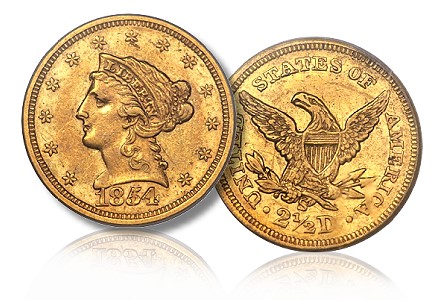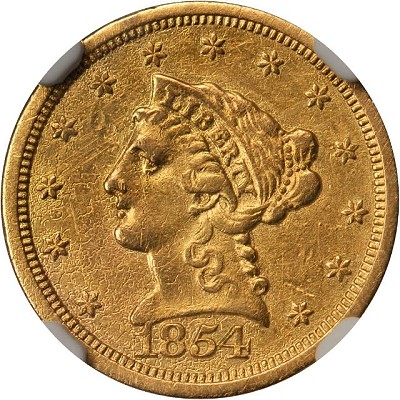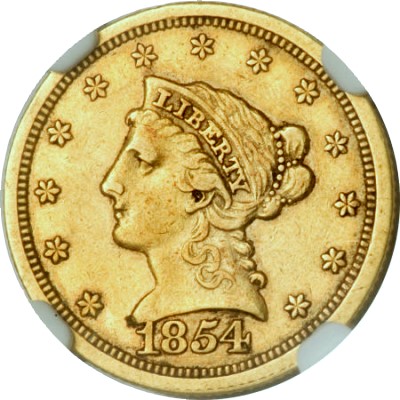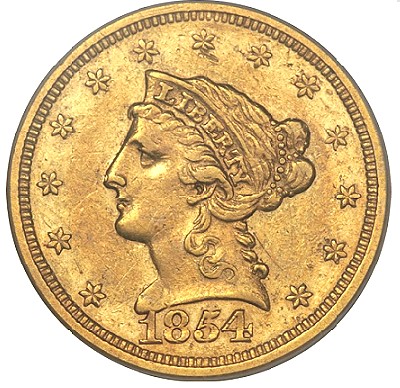News & Analysis on rare coins, markets, and the coin collecting community #74
A Weekly Column by Greg Reynolds
On Oct. 14th, in Pittsburgh, the Norweb-Richmond 1854-S Quarter Eagle (U.S. $2½ gold coin) will be offered by Heritage in an official ANA auction. It is PCGS graded ‘Very Fine-35.’ While this coin is the primary topic here, I remark upon 1854-S Quarter Eagles in general and I discuss other 1854-S Quarter Eagles as well.
Less than ten years ago, it seemed clear that the 1854-S was the rarest Quarter Eagle (U.S. $2½ gold coin) of any type. I almost stated as much in this column. As famous and important as the 1854-S issue continues to be, however, it is no longer clear that it is the rarest Quarter Eagle, though it probably is so. The 1863, the 1841, and the 1834 Capped Head are all in the same category of rarity, and a variety of 1804 Quarter Eagles needs to be addressed in this context. Indeed, a separate column or article is really needed to explore this issue and rank Quarter Eagles in terms of rarity. Such an undertaking will, I hope, be accomplished in the near future. After all, rare Quarter Eagles are ‘in the news.’ The Norweb-Richmond 1854-S is part of a collection of Liberty Head Quarter Eagles ‘by date’ that Heritage will offer on Oct. 14th, including the major rarities of this series.
 Though it may not be as rare as some experts previously thought that it was, the 1854-S Quarter Eagle is a Great Rarity and has tremendous historical significance. John Albanese, the founder of the NGC and later of the CAC, remarks that “the 1854-S has more charisma than the 1841 or the 1863. Being a business strike and an historical Branch Mint issue makes it more attractive to many collectors.”
Though it may not be as rare as some experts previously thought that it was, the 1854-S Quarter Eagle is a Great Rarity and has tremendous historical significance. John Albanese, the founder of the NGC and later of the CAC, remarks that “the 1854-S has more charisma than the 1841 or the 1863. Being a business strike and an historical Branch Mint issue makes it more attractive to many collectors.”
The U.S. Branch Mint in San Francisco officially began operating in 1854 and 1854-S Quarter Eagles are the first U.S. coins of this denomination to be struck in the West. Quarter Eagles were never struck at the Carson City (Nevada) Mint. Curiously, there are no 1855-S Quarter Eagles. In addition to being demanded by those who collect Liberty Head Quarter Eagles ‘by date,’ and by coin buyers who just enjoy acquiring Great Rarities, collectors who specialize in the era of the California Gold Rush are drawn to 1854-S gold coins.
Heritage will offer the Richmond 1854-S in Pittsburgh, as part of the official auction of the Fall ANA Convention. This will be the first ANA Convention to be held during the autumn season and, for the first time, three ANA Conventions will occur in one year, 2011. Last week, I wrote about an 1856-O Double Eagle in this same auction, though from a different consignor.
I. The Rarity of 1854-S Quarter Eagles
Even just six or seven years ago, many coin experts believed that only nine or ten 1854-S Quarter Eagles existed. Now, it seems that that there could be anywhere from eleven to sixteen. Indeed, Heritage cataloguers have itemized twelve as being different coins and have pointed towards other listings that may represent additional 1854-S Quarter Eagles. Their research is consistent with an estimate put forth by David Akers long ago of twelve to fifteen existing.
I have been tracking offerings of 1854-S Quarter Eagles for many years. I have held and examined seven different 1854-S Quarter Eagles. At this point, I cannot think of a compelling reason to challenge the research done by Heritage cataloguers or the earlier estimate by Akers. Even if Heritage cataloguers double counted one of the itemized twelve, circumstantial evidence indicates that there could be a few others, as they point out. For now, it makes sense to accept their research, especially since it is consistent with David Akers’ longstanding view.
Yes, if the 1804 Bust Right Quarter Eagle with thirteen, rather than the usual fourteen, stars on the reverse (back of the coin) were to be collected ‘as if’ it is a distinct ‘date,’ it may be the rarest Quarter Eagle. This issue, however, is a die variety, not a ‘date’ that is required for a set of Bust Right Quarter Eagles. There is difference between collecting ‘by date’ and collecting by ‘die variety.’ For every one person who collects a series ‘by variety,’ there are usually more than one hundred who collect the same series ‘by date.’ Collecting by ‘die variety’ is an extremely specialized undertaking, which requires a great deal of patience and some knowledge of the scientific aspects of manufacturing coins. Collecting ‘by date’ requires minimal knowledge, though I suggest that all collectors of classic U.S. coins seek the advice of experts.
II. The Last 1854-S to Sell At Auction
 The last 1854-S to sell at auction is the Atwater coin. It sold for $201,250 on Aug. 18th, during the Stack’s-Bowers ‘Rarities Night’ at the Summer ANA Convention. (Please see my five part series on this first ‘Rarities Night’ event: part 1, part 3, part 5.) The Atwater 1854-S was exhibited by Adam Crum of Monaco Rare Coins in 2007 and in 2008. It was ‘on the market’ in 2010.
The last 1854-S to sell at auction is the Atwater coin. It sold for $201,250 on Aug. 18th, during the Stack’s-Bowers ‘Rarities Night’ at the Summer ANA Convention. (Please see my five part series on this first ‘Rarities Night’ event: part 1, part 3, part 5.) The Atwater 1854-S was exhibited by Adam Crum of Monaco Rare Coins in 2007 and in 2008. It was ‘on the market’ in 2010.
The Atwater 1854-S is now in an NGC holder that says “AU DETAILS SCRATCHES, CLEANED”! Previously, it was an NCS holder. The NCS is an affiliate of the NGC.
There is no doubt about the fact that the Atwater 1854-S is not gradable. The current description of ‘scratches’ and ‘cleaned’ is misleading, as this coin has far more serious problems. Under five times magnification, it appears almost as though it is decaying. It may have been in a fire, or otherwise accidentally subjected to extreme heat. It also could have been treated with harmful chemicals. Much of the surface is damaged in a peculiar way. Even so, without magnification and strong lighting, this coin is not bad looking.
For a damaged coin, it is unusually attractive. It is a somewhat light, mellow tan-gold color. The detail level of the design elements is certainly in the Extremely Fine to Almost Uncirculated range. The rims are solid enough. In an odd way, this coin has some personality. For someone who would like to complete a set of Liberty Head Quarter Eagles, yet does not want to spend a vast sum, this ungradable 1854-S would have been an excellent choice, if the auction price had been substantially lower.
It is also true that this ungradable 1854-S has an impressive history. It is generally believed that it was previously in the William Atwater Collection, one of the dozen all-time greatest collections of classic U.S. coins. B. Max Mehl sold this collection in the mid 1940s. It was also in the Arthur Lamborn (“Fairfield”) collection, which Bowers & Ruddy auctioned in the 1970s. I refer to it as the Atwater-Fairfield 1854-S.
Before Aug. 18, I would have figured that the Atwater-Fairfield 1854-S would have been worth a price in the range of $125,000, at most $160,000. The price realized of $201,250 is very strong. This same coin was auctioned in 1995 for $22,000, a little more than one-tenth as much.
III. The Phillips 1854-S
Among the seven that I have seen, my favorite 1854-S is NGC certified Very Fine-35 with a star for eye appeal, or was so when Heritage auctioned it on July 31, 2009. As the catalogue indicated that it was “From the R. M. Phillips Limited Partnership Collection,” I will refer to it as the Phillips 1854-S. As far as I know, it has never been in an epic collection.
 After the auction, I was glad to read that Doug Winter was in full agreement regarding the Phillips 1854-S. “My favorite coin in the sale was an NGC VF35 1854-S quarter eagle. This coin had been off the market since 1991 and it was probably the nicest VF Liberty Head Quarter Eagle of any date I can recall seeing; let alone a Great Rarity like the 1854-S,” declared Winter in August 2009. While the Phillips 1854-S is my favorite among the ones that I have seen, I would not say that it was my favorite coin in the whole July 31, 2009 auction. There were some other terrific coins in that sale, too many to list here.
After the auction, I was glad to read that Doug Winter was in full agreement regarding the Phillips 1854-S. “My favorite coin in the sale was an NGC VF35 1854-S quarter eagle. This coin had been off the market since 1991 and it was probably the nicest VF Liberty Head Quarter Eagle of any date I can recall seeing; let alone a Great Rarity like the 1854-S,” declared Winter in August 2009. While the Phillips 1854-S is my favorite among the ones that I have seen, I would not say that it was my favorite coin in the whole July 31, 2009 auction. There were some other terrific coins in that sale, too many to list here.
The Phillips 1854-S scores very high in the category of originality and it has a neat look overall. Indeed, it looks much better in actuality than the catalogue images suggest. It has very few contact marks. Under five times magnification, evidence of a very light cleaning long ago is barely apparent. Overall, the Phillips 1854-S is evenly worn and has excellent natural color. It brought $253,000 on July 31, 2009. Winter thought that $253,000 was a strong price. I think otherwise. It was perhaps the best value in that whole pre-ANA Platinum Night event. While the Norweb-Richmond 1854-S has a similar degree of sharpness, and is attractive, the Phillips 1854-S is a much better coin, in my view.
IV. High Grade 1854-S Quarter Eagles
Higher grade 1854-S Quarter Eagles exist. I find, though, that the Phillips piece has a more natural appearance than the two higher grade pieces that I have seen. The finest known Bass-Parrino coin realized less than $150,000 in Oct. 1999. It was then PCGS graded AU-50 and was later NGC graded AU-53. In terms of sharpness, it is, indisputably, the finest known, and is an attractive coin overall. Further, if I accurately remember it, it did not have many contact marks. It should be worth more than a half million dollars now.
 At the February 2007 Long Beach auction, Laura Sperber was the successful bidder for an 1854-S that is PCGS graded ‘Extremely Fine-45.’ I would not argue about its certified grade. It just does not have quite the ‘original look’ of the Phillips 1854-S. It has been moderately cleaned extensively, which is not unusual for pre-1880 U.S. gold coins. As best as I can recall now, this coin did not have any severe problems or very noticeable contact marks. It sold for $345,000, which is the auction record for an 1854-S Quarter Eagle.
At the February 2007 Long Beach auction, Laura Sperber was the successful bidder for an 1854-S that is PCGS graded ‘Extremely Fine-45.’ I would not argue about its certified grade. It just does not have quite the ‘original look’ of the Phillips 1854-S. It has been moderately cleaned extensively, which is not unusual for pre-1880 U.S. gold coins. As best as I can recall now, this coin did not have any severe problems or very noticeable contact marks. It sold for $345,000, which is the auction record for an 1854-S Quarter Eagle.
In Sept. 2005, in Los Angeles, ANR auctioned a newly emergent 1854-S. Reportedly, the “C. L. Lee” coin had been owned by a San Francisco area family since the 19th century. It is or was NGC graded ‘EF-45’ and sold for $253,000. Doug Winter has publicly stated that he was the successful bidder at this auction for the ‘C. L. Lee’ 1854-S. I have never seen it. A leading dealer indicated to me that the ‘C. L. Lee’ coin is very similar to the just mentioned PCGS graded “EF-45” 1854-S.
V. The Norweb-Richmond 1854-S
The 1854-S that Heritage will auction in October was previously in the Norweb, Richmond and Roswell Collections. The Norweb family had one of the six all-time greatest collections of classic U.S. coins. The vast majority of the Norwebs’ U.S. coins were auctioned by B&M of New Hampshire. Three Norweb sales of U.S. coins were conducted in New York, one in 1987 and two in 1988.
A collector in the Midwest formed the Richmond Collection over a period of many years. The Richmond Collection is probably one of the fifteen all-time greatest collections of classic U.S. coins, certainly it is in the top twenty. While the Richmond Collection was never as great as the Norweb Collection, the Richmond Collection has not received the attention and analysis that it deserves. Other than my series of articles in Numismatic News, no one else has written about it, as far as I know.
 Yes, the Richmond Collection was lacking in early copper and in bust silver coinage. The Richmond collector, however, had every single Eagle, except a 1795-nine leaves, from 1795 to 1933. He had a complete set of business strike Saints. His collections of Liberty Seated coins were amazing, with nearly complete sets of business strikes and extensive runs of Choice or Gem Proofs. He had an 1870-S dollar and an 1842 ‘Small Date’ Quarter, among many other prizes in series of Liberty Seated coins. Moreover, he had the finest known 1894-S Barber Dime. Although I could list many more rarities that were in the Richmond Collection, the topic here is 1854-S Quarter Eagles.
Yes, the Richmond Collection was lacking in early copper and in bust silver coinage. The Richmond collector, however, had every single Eagle, except a 1795-nine leaves, from 1795 to 1933. He had a complete set of business strike Saints. His collections of Liberty Seated coins were amazing, with nearly complete sets of business strikes and extensive runs of Choice or Gem Proofs. He had an 1870-S dollar and an 1842 ‘Small Date’ Quarter, among many other prizes in series of Liberty Seated coins. Moreover, he had the finest known 1894-S Barber Dime. Although I could list many more rarities that were in the Richmond Collection, the topic here is 1854-S Quarter Eagles.
The gold coins from the Richmond Collection were auctioned by DLRC in July 2004 at the Grand Hyatt Hotel in New York. For the Richmond 1854-S, Steve Contursi was the successful bidder, at $86,250. In 2005, John Hamrick acquired the Richmond 1854-S from Contursi and sold it to the individual who assembled the ‘Old Roswell Mill Collection.’
From 2001 or ’02 to 2007, a client of Hamrick’s built a tremendous coin collection consisting of many rarities and complete sets of some series. As this collector does not wish for his name to be revealed, he named his collection the ‘Old Roswell Mill Collection’ and I refer to him as Roswell. He owned this 1854-S for two to three years. Please click here to read about the Roswell Mill Collection.
According to the Heritage catalogue, the Richmond-Roswell 1854-S is now in “The Baltimore Collection, part two.” About three years ago, Heritage auctioned Liberty Head Double Eagles from the same consignor. It seems clear that Mr. “Baltimore” collected Liberty Head Quarter Eagles ‘by date.’ He added two ‘Proof-only’ dates, the 1841 and the 1863, to his set of business strikes. Mixing business strikes and Proofs in the same sets was a widely accepted practice before the 1990s. Eliasberg and the Norweb family, among many others, did so. As I have discussed in many other writings, I continue to favor such a practice in regard to the building of sets of high quality 19th century coins.
As for the characteristics of the Norweb-Richmond-Roswell-Baltimore 1854-S, I wrote just a few notes in the past and my recollection of this coin is not crystal clear. It was relatively sharply struck, with well formed design elements. It has numerous contact marks, including more than a few medium scratches and a few digs. I believe, though I am not sure, that my notes indicate that I found it to have been lightly to moderately cleaned long ago. I am sure that I regarded it as a ‘cute coin’ that is attractive overall, though the scratches are a little bothersome. It may make sense to value it as a ‘Very Fine-20’ or ‘VF-25’ grade coin, rather than as a VF-35 grade coin. It was NGC certified as ‘VF-35’ and, at some point, ‘crossed over’ into a PCGS holder.
In any event, the Norweb-Richmond-Roswell 1854-S is dramatically more desirable than the Atwater-Fairfield 1854-S that realized $201,250 in August. It will be interesting to see how the Norweb-Richmond-Roswell 1854-S fares in October. I am also very interested in the 1841, the 1863 and the two 1864 Quarter Eagles in this same auction. These are all important rarities.
©2011 Greg Reynolds





I have one of the 1854 $2.50 Liberty coins with the Eagle on the back that I inherited from my father. I have not had it authenticated yet. What does the S stand for after your designation of 1854? Is it on the coin?
The “S” designation is a mintmark that denotes that the coin was struck in San Francisco.